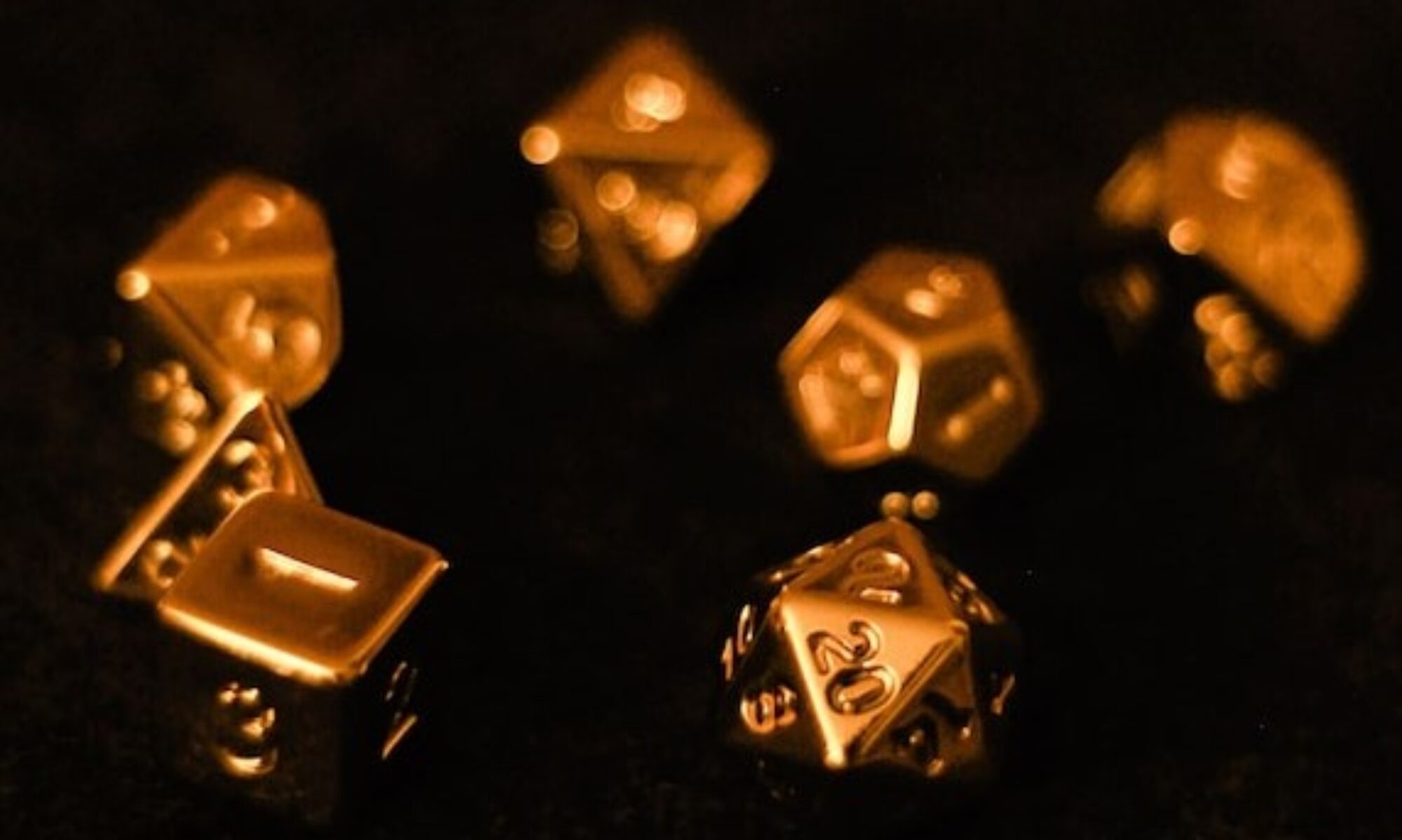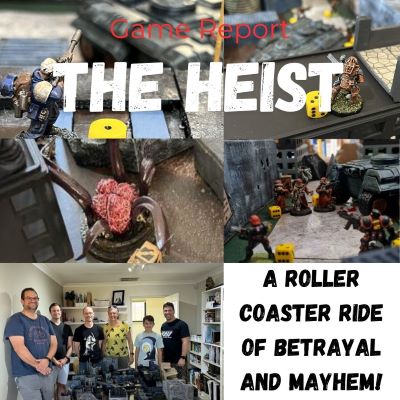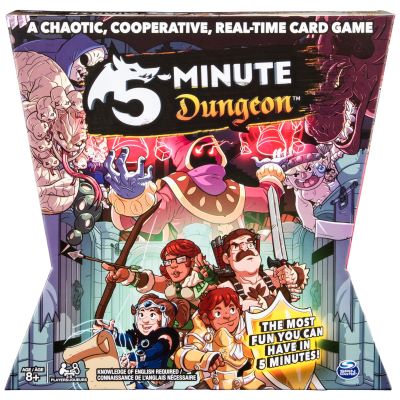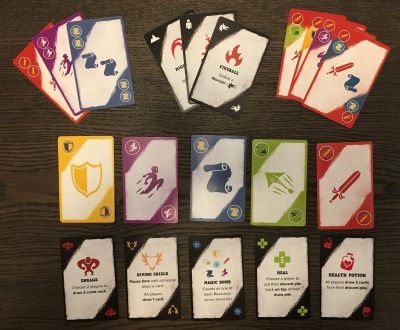Late last year I finally managed to get my scenario “The Heist” to the table. We ended up with six players, one of whom had never played miniatures games before. You can find out about the scenario design here and download the players pack here. Our heist game report gives the exciting detail below. In summary, we had a blast. The game narrative was introduced as follows:
We return to Luthca IV an Imperial world beset by heresy and peril.
Rich in mineral deposits Luthca IV was designated an Industrial World by the Administratum 1000 years ago. Now the planet is covered in strip mines and huge factory complexes pumping noxious fumes into the atmosphere. What remains of the once lush environment is bare trees, acidic mud and heavily polluted oceans. Three Hive Spires shield the population from the worst of the toxins and provide workers who keep the production lines on schedule.
The Imperial Governor and his staff sit at the top of Crown Spire far above the thick clouds of polluted air. High Imperial tithes continue to put pressure on the factories and mines to produce more than ever before. The guilds are stretched, and the Hive cities seethe with discontent. It is all the Governor can do to hold the peace.
The Silent Trade is the illegal trade of xenos commodities and technology by unscrupulous individuals who deal with the alien either for profit or for survival’s sake. Though highly-frowned upon by the Inquisition, many of these items are not considered outright illegal in the Imperium of Man due to the impossibility of categorising and banning every item, device, or object that may or may not have been made by nonhuman hands. What’s more they fetch a staggeringly high price when sold to the right people.
One such item has come to light.
An archotechnology expedition of the Adeptus Mechanicus uncovered something valuable out in the polluted sands of the Cinder Desert. This ancient artefact known only as the endless light is whispered to bestow great power to those who use it. But at what cost?
The expedition sent the artefact in an armoured convoy headed for the Adeptus Mechanicus conclave in Hive Secundo. But it was ambushed on the outer reaches of the hive and the guards massacred. Before the bandits could secure their loot a terrible maelstrom roared in from the desert, killing the hapless villains and leaving the priceless artefact unguarded.
Word spread fast.
Whoever could get their hands on this artefact would be rich beyond their wildest dreams. Buying themselves out of the grim existence of the underhive.
But there is a complication. The Adeptus Mechanicus were not born yesterday, they have secured their valuable find in a secure vehicle that requires a code to open. Despite the best efforts of the Fixers and Data Thieves only parts of the code have come available. The freebooters chasing this prize must work together if there is any hope of untold wealth.
Not only that, but the maelstrom has stirred up the Rad Ghouls from the Cinder Desert. Nothing a little las fire can’t take care of…
The race is on.
So how did the game unfold? Did the players feel the pressure around their decisions? Let’s find out.
Set Up
As per my scenario introduction I set the table up with the crashed APC dead center. The crew entry points (red tokens) were distributed around the edge with terrain placed to ensure it was a relatively safe place to join the game from. Of course, the remaining terrain was placed to resemble a claustrophobic under hive setting reminiscent of games like Necromunda.
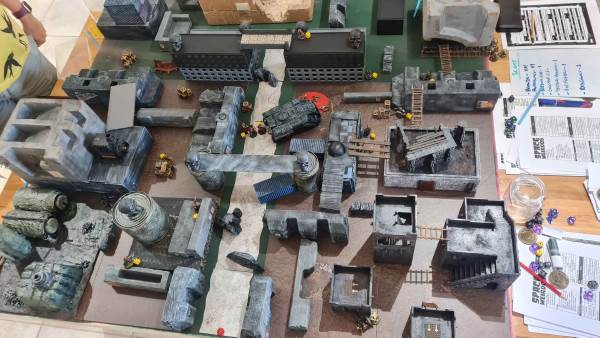
Each player was given a crew sheet and chose a trio of miniatures to represent their team. Next, they had to name their crew and state their faction affiliation (Inquisition, Criminal Underworld, Adeptus Mechanicus or Evil Cult). As always, my players were pretty creative. Here are the crews:
- The Professionals (criminal underworld)
- Cognitive C’s (adeptus mechanicus)
- Heralds of the Star Children (evil cult)
- Hectors Hellions (inquisition, but secretly evil cult)
- Bleeding Eyes (secretly affiliated to the evil cult)
- Hive fighters (affiliation unknown)
Perhaps unsurprisingly, the evil cult was a tad over represented…
With the crews were named, starting locations allocated and paper provided for secret messaging, the game was afoot.
Tension Builds
Almost immediately secret messages started flying around the table as fledgling alliances were brokered. In addition, the crews were cautiously moving towards the central objective. It began to play out like an old western shootout. Protagonists circling one another but not drawing their weapons until the last possible moment.
A surprisingly large horde of ravening rad ghouls entered play after the first turn throwing more chaos and panic into the mix.
Tension increased dramatically over the following turns as alliances were firmed up and crew members got closer and closer to the prize. Rad ghouls maintained their pressure, harrying lone crew from the edges of the board.
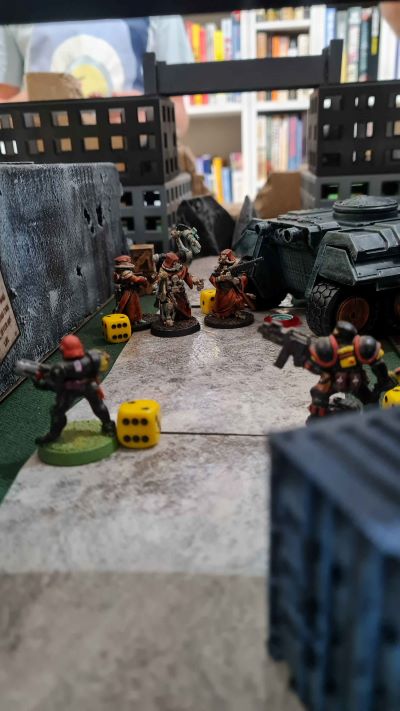
All Hell Breaks Loose
A couple of players (Hectors Hellions and Cognitive C’s) broke the tension, declaring their true intentions too early. Consequently, the shooting started and didn’t really stop. Crew members went down left and right, alliances went out of the window and a bloodbath ensued.
The alien artefact was recovered. However, the last remaining member of the Hive Fighters decided to open it, seeking immortality. Changing the game forever.
I want to make it clear, during game setup I had warned the participants that opening the artefact would probably be a bad thing. So there should have been no surprises when….
Survival Horror
The unsuspecting Hive Fighters unleased a horror. In a scene reminiscent of Raiders of the Lost Ark, our witless crewman turned into a warp fueled abomination and began hunting those few remaining team members. This invincible monstrosity began teleporting around the board to the horror of the other players. Not many escaped before we called the game and tallied up the scores.

Feedback
The game ended up being really close, with the Bleeding hearts winning by one point. Excitement right up until the end.
But did we get emergent play and did the players wrestle with decision making?
Yes and yes!
Feedback afterwards included:
- Desperate to get to the artifact and open it I tried to make a few alliances with others but was always wary that I might get back stabbed. Probably because I was going to do a bit myself.
- Love the narrative based skirmish as it just adds a little more to the one off battles and gets me invested in my gang as I make stories up about them and why they are getting into the fight.
- I absolutely loved the end of the game with the great warp entity being ripped onto the table and chasing everyone down. So freekn cool!!!!!
- Regarding alliance forming. It was strong at the start. I had a hunch on my neighbours plans and so took the light touch approach. The alliances had no bearing on the second stage of the game with just a mad panic to get away.
- Decision making was fraught with risk. I wanted to position myself furthest away from the prize because getting the artefact was going to be tricky. So I let the other crews sort it out. The cooperative element makes it so much more fun.
- The rad-ghouls gave a great element of randomness and we had to watch lots of sides.
- The warp creature was a perfect surprise, flipping the game on its head.
- All up, changing dynamics, great narrative and tons of fun.
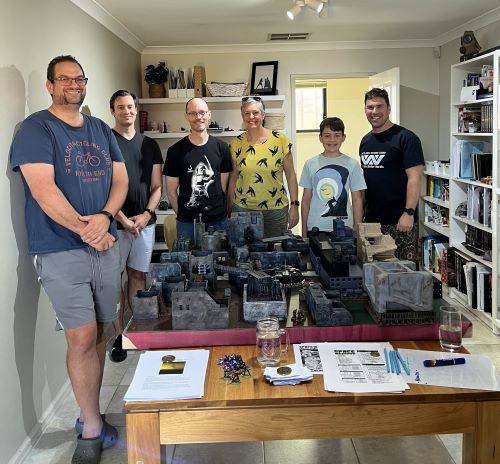
Wrap Up
Emergent play definitely came to the fore with players creating personalities for their gangs. Additionally, uncertain alliances, secret messages and tension building to a cinematic gunfight also played out in unique ways. The monster ending completely flipped that game which was unexpected but which the players completely got on board with.
Decision making for the players was intended to be difficult and I think I succeeded here. Multiple decision points had to be wrestled with including:
- Who to ally with and whether to declare alliances openly
- If and when to break alliances
- Whether to pursue the artefact early or late in the game
- Use crew members to guard against possible rad ghoul incursions
- Safest route through the board towards the objective
- Whether to open the artefact (despite being warned it was a bad thing)
Last Thoughts
Ultimately, this scenario succeeded. Players had fun, which should of course be the priority. Decision making was tough and emergent gameplay rose to the surface.
One thing that worked really well was the opening of the artefact. Despite warning players of the potential dangers of doing so, it was still opened. Which of course, was a fantastic result. To encourage the players to open it I had a sealed envelope with new rules inside that would be opened by the player who took this choice. I positioned this on a shelf above the board in full view. Having this prop definitely piqued the players curiosity, ultimately creating the survival horror endgame to take place. Needless to say, I will be using props in this way in future.
So, a joy to design, run and play. I cant wait to run the next one!
